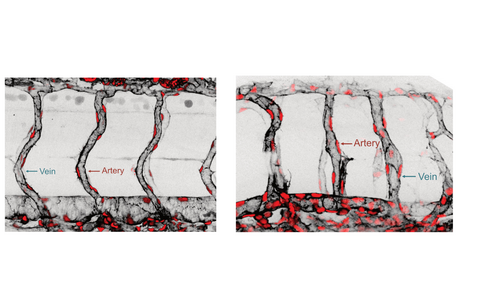Always toward the arteries
Stretching some 150,000 kilometers, human blood vessels form a widely branching network, which supplies even remote parts of the body with oxygen and nutrients. The more vessels leading away from the heart branch out, the finer they become. While the main artery in the body, the aorta, has a diameter of around three centimeters, the tiniest capillaries are just a few microns in diameter.
The situation is similar on the way back to the heart. The diameter of tiny venules, which transport oxygen-poor blood, is in the two- to three-digit micron range. But the two vena cavae that flow into the heart have a diameter of two centimeter.
Understanding malformations of the blood vessels
Our research can contribute to a better understanding of congenital vascular malformations
“It was previously unknown how a newly formed vessel obtains the suitable diameter and continually maintains this throughout its entire length,” says Professor Holger Gerhardt, leader of the Integrative Vascular Biology Lab the Max Delbrück Center for Molecular Medicine in the Helmholtz Association (MDC) in Berlin. Together with researchers from the German Centre for Cardiovascular Research (DZHK) in Berlin, the Berlin Institute of Health (BIH) and the University of Edinburgh in Scotland, Gerhardt and his team have been investigating this question.
“Our research can contribute to a better understanding of congenital vascular malformations – such as the development of shunts in which arteries and veins are directly connected, which means that the tissue can no longer be adequately supplied with fresh blood through the capillaries,” Gerhardt explains. His study, which recently appeared in the scientific journal Development, was funded by the DZHK, the German Federal Ministry of Education and Research (BMBF), the European Research Council (ERC) and the Leducq Foundation. The lead authors of the publication are the developmental biologist Dr. André Rosa and the mathematician Dr. Wolfgang Giese, both postdocs in Gerhardt’s lab.
Migration against the bloodstream
“In experiments with transparent zebrafish larvae, we were able to observe how arteries and veins initially form,” Gerhardt reports. His team focused on the endothelium, the inner lining of blood vessels, to understand how vessels sprout and connect. “This involved following each individual endothelial cell as it migrated through the organism,” the researcher says. The scientists then analyzed numerous live recordings on a computer using mathematical models.
The number of cell divisions determines the diameter of the veins. In arteries, on the other hand, the diameter is determined by the targeted migration of cells from the veins. “So the cells actively migrate against the flow of blood into the forming arteries,” Gerhardt explains. “If they don’t do this, the veins become too thick and the arteries too thin – and shunts are also formed and remain in place.”
A protein regulates migration
Blood vessels of a zebrafish embryo: expression of the Wiskott-Aldrich gene is reduced in the right image. The actin filaments in the cell cytoskeleton are shown in black, nuclei of endothelial cells in red.
In the next step, the researchers looked into whether cell migration from veins into arteries is controlled by a specific gene. “We first examined the genetic material that regulates the actin cytoskeleton, which is involved in all cell movements in the organism,” Gerhardt recounts. “Surprisingly, we saw that the gene for a protein called WASp is extremely active in endothelial cells.”
The abbreviation WASp stands for “Wiskott-Aldrich syndrome protein,” which is essential for the function of the cytoskeleton. If it is defective, it can cause a hereditary immune disorder. “Until now, it had been thought that the WASp gene was expressed only in white blood cells,” says Gerhardt. “It did not seem to play a major role in endothelial cells.”
However, this assumption turned out to be false. “After we specifically switched off the WASp gene in some zebrafish larvae, the targeted migration of endothelial cells toward the arteries did not occur and shunts became more frequent,” Gerhardt reports. This observation is particularly interesting because people with an altered WASp gene sometimes suffer from recurrent aneurysms. An aneurysm is a balloon-like bulge in the wall of blood vessels, usually occurring in arteries. If it ruptures, it can result in a life-threatening loss of blood.
Research using human tissue
Now Gerhardt and his colleagues would like to verify the extent to which their observations can be transferred to humans. “We want to find out whether the mechanism we have discovered plays a role in the development of diseases and, if so, to what extent this can be influenced,” Gerhardt says. His research not only focuses on the rare Wiskott-Aldrich syndrome. It is also conceivable that an altered WASp gene could lead to pulmonary hypertension, which occurs much more frequently.
Text: Anke Brodmerkel
Further information
Literature
André Rosa, Wolfgang Giese et al. (2022): „WASp controls oriented migration of endothelial cells to achieve functional vascular patterning“, Development, DOI: 10.1242/dev.200195







